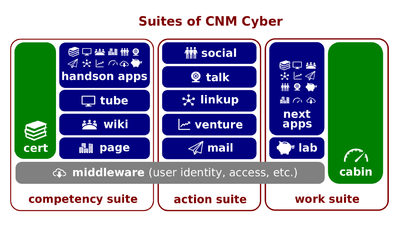Difference between revisions of "Tech Report Metadata"
(→Script) |
(→Key terms) |
||
| Line 23: | Line 23: | ||
===Key terms=== | ===Key terms=== | ||
| − | :[[ | + | :[[Document metadata]], [[descriptive metadata]], [[discovery metadata]], [[historical metadata]], [[structural metadata]], [[administrative metadata]], [[legal metadata]], [[distribution metadata]], [[technical metadata]], [[copyright]], [[copyleft]] |
===Closing=== | ===Closing=== | ||
Revision as of 22:04, 18 November 2020
Tech Report Metadata (hereinafter, the Lectio) is the lesson part of Technical Report Essentials lesson that introduces its participants to technical report concepts. This lesson belongs to the CNMCT Entrance section of the CNM Cyber Placement.
Content
The predecessor lectio is What Tech Report Is.
Script
- With regard to reports, metadata is data about report content. The ANSI/NISO Scientific and Technical Reports standard defines three categories of the metadata associated with technical reports.
- Descriptive metadata is the data that helps the user find a report and distinguish it from other similar ones. The descriptive data can be further divided in discovery and historical metadata. Report's title, creator, publisher, date of creation, and language are examples of the discovery metadata. The historical metadata provides historical data on any operations with the content data such as its creation, storage, modification, verification, and/or validation.
- Structural metadata is the data that explains the relationship between parts of multipart objects and enhance internal navigation. Report's table of contents, list of figures and tables, glossary, and document index are examples of the structural metadata.
- Administrative metadata is the data that supports maintaining and archiving reports and ensure their long-term availability. The administrative data can be further divided in legal, distribution, and technical metadata.
- Copyright is the exclusive legal right to reproduce, publish, and distribute any work product that has an identifiable owner. Other legal metadata include non-exclusive rights such as copyleft.
- Distribution list is an example of the distribution metadata that specifies the intended recipients and ways of distribution, if those recipients and ways are restricted.
- Report's file type, database key, archiving possibility, specifications, and end-user documentation are examples of the technical metadata. This data specifies how the report can be accessed and managed.
- There is no correlation between sizes of report content and its metadata. For instance, CNM Wiki's historical metadata contains all the revisions of any wikipage. This metadata can be accessed via the "View history" tab. If some page has undergone hundreds of revisions, only historical metadata can be hundreds of times bigger than the current page content.
Key terms
- Document metadata, descriptive metadata, discovery metadata, historical metadata, structural metadata, administrative metadata, legal metadata, distribution metadata, technical metadata, copyright, copyleft
Closing
The successor lectio is What Wiki Edits Are.
